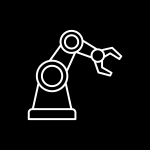Why do we need Sound Design for Robots?

One of the most important aspects of designing robots is sound design. UX sounds, notification sounds, and voice design all play a critical role in making robots feel friendly and approachable. But they also serve a practical purpose: helping people understand what the robot is doing and why. Sound design can also help robots stand out from the crowd. With so many new robotics companies popping up, it’s more important than ever to create a unique and memorable brand. And one way to do that is through sound. By carefully crafting the sonic identity of your robot, you can make it instantly recognizable and unforgettable.
Lifelike sound design
As we continue to design ever-more realistic and human-like robots, it’s important to consider how sound can play a role in the user experience. From the subtlety of notification sounds to the more overt voice design, sound can help create a feeling of personality and connection. One area where sound is particularly important is in creating a sense of presence. As robots become more lifelike, it’s crucial that they also sound lifelike. This means creating sounds that are not only realistic, but also convey the emotional state of the robot. For example, a happy robot might have a higher-pitched voice, while a sad robot might have a lower-pitched voice. Another important consideration is how different sounds can be used to create a sense of identity. Just as we use different voices for different characters in a movie or video game, so too can we use different sounds for different types of robots. This helps users to quickly and easily identify the type of robot they are interacting with. Finally, we must also think about how sound can be used to create a feeling of safety and trust. As robots become more ubiquitous in our lives, it’s important that they instill a sense of trust in their users. One way to do this is through the use of calming and soothing sounds. This can help users feel more relaxed and comfortable around these sometimes daunting machines. By considering all of these factors, we can create sound designs for robotics that are not only realistic and believable, but also emotionally engaging and humanizing.
Tonality
Another important aspect of sound design for robotics is tonality. Tonality is the emotional quality and connotation associated with a sound or voice. This is an especially important consideration when creating UX sounds and notification sounds, as they may be designed to convey a particular feeling or emotion. For example, a notification sound might be designed to be calming and gentle, while a warning sound should be more urgent and alarming. Similarly, when designing for voice recognition technology, good tonality can help create an engaging experience for users by making the voice seem more natural and friendly. The tone of voice used in robotic applications should also be carefully considered to ensure that it conveys the desired message. Different types of voices have different connotations which can influence how users interact with them. For example, a robotic voice that speaks in a pleasant and inviting tone may encourage users to interact with it more often than if it spoke in an abrupt or harsh tone. Additionally, synthetic voices should also be designed to fit the context of the application – for example, a robotic assistant designed for children’s applications would require a different type of voice than one designed for professional settings.
Context
Finally, when designing sound effects or music for robotics applications, composers should consider how their work will fit into the larger context of the application. Music or sound effects can draw attention to key features or provide cues that enhance user experience. They can also create an immersive atmosphere which helps users feel comfortable in the application environment. Overall, sound design for robotics should take into account both tonality and context in order to create an engaging user experience. By considering how different types of sounds evoke emotional responses and fitting them into the larger context of an application, designers can craft audio experiences that encourage users to interact with robotic applications more often and effectively.




Five key categories of sound design for robots
There are five key categories of sound design for robots: environment, movement, identity, emotion, and communication. Each of these categories serves a distinct purpose and can be used to create a unique and memorable robotic experience. Environment sounds help to create a sense of place and contribute to the overall atmosphere of the robot’s surroundings. Movement sounds help to convey the robot’s physicality and presence, while identity sounds help to establish the robot’s unique personality. Emotion sounds are critical for conveying the robot’s emotional state and engaging with users on an emotional level. Finally, communication sounds are essential for conveying information about the robot’s actions and intentions. By considering all five of these categories, designers can create robots that are not only functional but also delightful and engaging to interact with.

1. Environment
2. Movement
3. Identity
4. Emotion
5. Communication.
Our expertise in the field of robotic sound design includes UX sound design for cobots, medical robots and industrial robotic solutions.
—
Contact person for project inquiries:
Rainer Hirt
+ 49 (0) 75 31 36 38 524
robotic (at) audity.co
